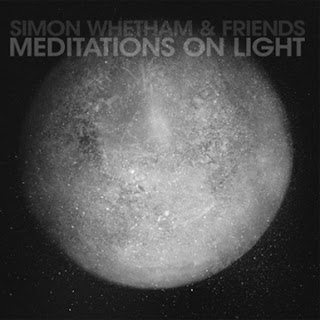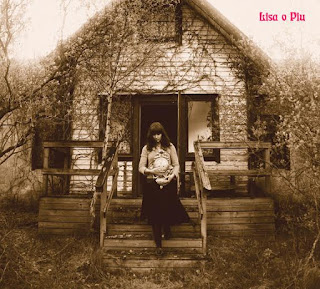When This Was the Future (2009)
This is the debut full-length release by Sweden's Lisa Isaksson and
her band Lisa o Piu. Raised in a small town on the outskirts of
Stockholm, she spent most of her time drawing sketches in horse stables.
Later, these horse drawings would become song lyrics accompanied by her
mother's old guitar, recorded on a 4-track. Through the years, she
eventually formed the band Piu together with her school buddies, and
their first single was released in Scotland in 2007. The single got a
lot of good reviews and Lisa and Piu gave a couple of concerts on the
British Isles as well as home in Stockholm. They also had the
opportunity to perform with the British folk musician Roger Wootton who
led the legendary acid-folk band Comus during the early 1970s. The
performances went so well that they were released as a live album. As
summer came and turned Sweden into a green and pleasant place again, the
core members of Piu went to a small cottage in the beautiful
archipelago north of Stockholm and recorded what was to become When This
Was The Future. The album is filled with delicious and bewitching
woodland folk hymnals, eloquent yet eerie, and led by Lisa's gossamer
vocals, as delicate as a wavering candle flame. The album is produced by
Mattias Gustavsson (Life On Earth!/Dungen), and it somehow divinely
conjures the essence of Linda Perhacs, Bridget St. John, Joni Mitchell,
Sandy Denny, Vashti Bunyan, and Joanna Newsom into one singular siren,
but with a thoroughly unique, thoroughly haunting delivery.
Lisa Isaksson (vocals, guitar, flute, piano, percussion), Anders
Engqvist (accordion, percussion, clarinet), David Svedmyr (electric
guitar, 12-string guitar, bass pedals, mellotron, percussion), Joel
Munther (bass, acoustic guitar, vocals), Jennie Ståbis (vocals,
melodica, percussion), Maria Lagerlöf (vocals, flute, percussion)
Lisa O Piu may be lagging a few years behind the prime of the psych-folk
revival but their debut album When This Was The Future is another gem
that’s worthy of comparisons to venerable oldies like Vashti Bunyan and
Linda Perhacs, as well as their musical descendants Fern Knight and
Joanna Newsom. But this is not New Weird America; Lisa O Piu are a
Swedish quintet fronted by the captivating Lisa Isaksson. The Latin word
“Più” roughly translates to “more”, while the O (short for “och”, the
Swedish word for “and”) is a hangover from Lisa’s solo project Lisa O
Lillportan, “lillportan” being a colloquial word for her four-track
recorder. Her first recording, Cantering, was one of those
excruciatingly limited CD-Rs that went out of print so fast that most
people didn’t even have time to blink. There were 30 copies made. We’re
not even kidding. But even if we never get to hear it, Cantering
certainly set the agenda, not least with laying bare Lisa’s lifetime
passion for horses.
Following the release of their debut single, ‘Waves, Whisperers, Hunters
& Sailors’ (popular in Scotland, apparently), Lisa and her friends
ventured to an archipelago north of Stockholm to start work on When This
Was The Future with the midnight sun snapping at their consciousness.
The flawless production comes from Dungen’s Mattias Gustavsson, who
succeeds in bringing out the best and most chilling elements of Lisa’s
delicate voice. The album is already out in Sweden; Subliminal Sounds
will do the honours in the UK on October 26th.
Alan Pedder, "Wears The Trousers Magazine"
_____________________________________________________________________________
Behind The Bend (2010)
Brand new album from this bewitching Swedish folk siren and her band.
This is the follow up to last years critically acclaimed debut album
“When this was the future”*. : Few of psych-folk's recent exponents have
come close to matching the debut from Lisa Isaakson... Narnian
harmonies and an air of wintry wonderment defy you not to give yourself
wholly to what you're hearing" THE TIMES 5/5 . "Between Vashti Bunyan's
innocence and Sandy Denny's knowingness, Linda Perhacs' hippy spells and
Espers' retro folk sorcery... on this evidence, northern European pagan
psych-folk is alive and well" MOJO
To get inspiration for the creation
of the new album “Behind the Bend” Lisa spent time in a small cottage
located deep in the vast woods of Vastmanland, Sweden, where she enjoyed
the last breath of the summer. Every evening she and David walked
further in to the woods to an old rowing boat that lay on the edge of a
forest lake. In the light of the magically ever glowing Swedish summer
midnight sun they paddled across the lake and then further along a
forest creek with lush green trees that hangs down over the fresh
running water and water lilies. This is the kind of set and setting
where you travel into another world….and they did. The initial
recordings were made under a vaulted blue ceiling with gold stars in the
old 15th century timber church of Hjulsjo, Sweden. The new album is filled with delicious and bewitching watery woodland
folk hymnals, eloquent yet eerie. The harp has been given more space,
the violin plays a greater role, the twelve-stringed guitar plays
graceful melodies and all is led by Lisa's gossamer vocals, as delicate
as a wavering candle flame. Come along for the ride.
Ask for download links in comments.





















